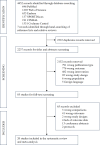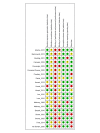Exergame-Based Behavior Change Interventions for Promoting Physical Activity: Systematic Review and Meta-Analysis of Randomized Controlled Studies
- PMID: 40779747
- PMCID: PMC12334110
- DOI: 10.2196/62906
Exergame-Based Behavior Change Interventions for Promoting Physical Activity: Systematic Review and Meta-Analysis of Randomized Controlled Studies
Abstract
Background: Physical inactivity is defined to be an activity level insufficient to meet recommendations. Exergame, which refers to a combination of exercise and video games, has the potential to promote physical activity (PA). Behavior change techniques (BCTs), the minimal, replicable components of an intervention, are widely used to identify components used in health behavior promotion.
Objective: A systematic review and meta-analysis of randomized controlled trials (RCTs) was conducted to examine the overall effects of exergame-based interventions for promoting PA and their influencing factors. BCTs were also identified and discussed in this review.
Methods: We searched for relevant RCTs across 6 databases from their inception to March 21, 2024. Meta-analyses using random-effects models assessed the effects on PA, moderate to vigorous physical activity (MVPA), light physical activity, moderate physical activity, vigorous physical activity, sedentary time, step count, and BMI. Subgroup analyses of PA were conducted to explore the influencing factors of exergame-based behavior change interventions. Review Manager software (version 5.3; Cochrane Collaboration) and Stata software (version 16; StataCorp) were used to analyze data.
Results: A total of 20 RCTs targeting populations with various medical conditions (aged between 7.5 and 79 years; 1073/2211, 48.5% female) were included in this review, with sample sizes ranging from 16 to 1112. Exergame-based behavior change interventions significantly increased PA (standard mean difference [SMD] 0.19, 95% CI 0.05-0.33), MVPA (SMD 0.48, 95% CI 0.12-0.85), and step counts (SMD 0.54, 95% CI 0.13-0.94). Furthermore, subgroup analyses showed that intervention implementer (research assistants vs other implementers), game console (Microsoft Xbox vs Sony PlayStation vs Nintendo Wii), game participation type (individual game vs nonindividual game), measurement method (subjective vs objective), and the number of BCTs (n<7 vs 7≤n<10 vs n≥10) used significantly influenced the effectiveness of these interventions. The most frequently used BCTs included "1.4 action planning" (n=15), "1.1 goal setting" (n=13), "12.5 adding objects to the environment" (n=13), "2.3 self-monitoring of behavior" (n=11), and "4.1 instruction on how to perform the behavior" (n=11).
Conclusions: Our review has demonstrated that exergame-based interventions are effective in promoting PA. Future trials are needed to further validate the insights proposed in our studies and assess the long-term effects on PA.
Keywords: behavior change; behavior change techniques; cost-effective; exercise; exergame; intervention; life expectancy; noncommunicable diseases; physical activity; promotion; randomized controlled studies; systematic review; video games.
© Si-Jia Li, Hao-Ming Ma, Lin-Qing Zhu, Hong-Yu Yu, Ao-Qi Wang, Xing-Yi Tang, Run-Yuan Pei, Mei-Hua Piao. Originally published in the Journal of Medical Internet Research (https://www.jmir.org).
Conflict of interest statement
Figures




Similar articles
-
Interventions for promoting habitual exercise in people living with and beyond cancer.Cochrane Database Syst Rev. 2018 Sep 19;9(9):CD010192. doi: 10.1002/14651858.CD010192.pub3. Cochrane Database Syst Rev. 2018. PMID: 30229557 Free PMC article.
-
Interventions for promoting habitual exercise in people living with and beyond cancer.Cochrane Database Syst Rev. 2013 Sep 24;(9):CD010192. doi: 10.1002/14651858.CD010192.pub2. Cochrane Database Syst Rev. 2013. Update in: Cochrane Database Syst Rev. 2018 Sep 19;9:CD010192. doi: 10.1002/14651858.CD010192.pub3. PMID: 24065550 Updated.
-
Interventions implemented through sporting organisations for promoting healthy behaviour or improving health outcomes.Cochrane Database Syst Rev. 2025 Jan 13;1(1):CD012170. doi: 10.1002/14651858.CD012170.pub2. Cochrane Database Syst Rev. 2025. PMID: 39803834
-
Systemic pharmacological treatments for chronic plaque psoriasis: a network meta-analysis.Cochrane Database Syst Rev. 2021 Apr 19;4(4):CD011535. doi: 10.1002/14651858.CD011535.pub4. Cochrane Database Syst Rev. 2021. Update in: Cochrane Database Syst Rev. 2022 May 23;5:CD011535. doi: 10.1002/14651858.CD011535.pub5. PMID: 33871055 Free PMC article. Updated.
-
Physical activity and exercise for chronic pain in adults: an overview of Cochrane Reviews.Cochrane Database Syst Rev. 2017 Jan 14;1(1):CD011279. doi: 10.1002/14651858.CD011279.pub2. Cochrane Database Syst Rev. 2017. Update in: Cochrane Database Syst Rev. 2017 Apr 24;4:CD011279. doi: 10.1002/14651858.CD011279.pub3. PMID: 28087891 Free PMC article. Updated.
References
Publication types
MeSH terms
LinkOut - more resources
Full Text Sources
Medical

